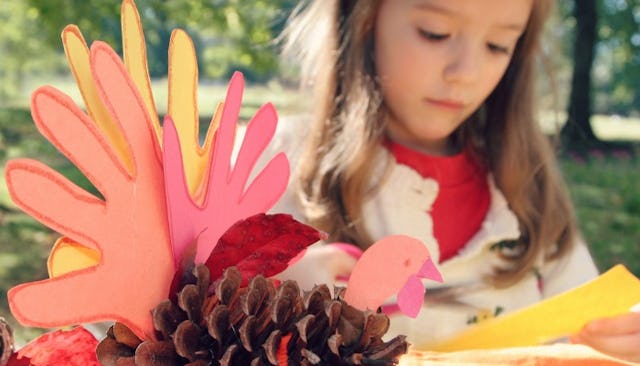It's Important To Tell Our Kids The Truth About Thanksgiving

I’ll admit it. I never told my kids about Thanksgiving in the first place. They’re homeschooled, so I had the choice, and I chose to ignore the pat Pilgrim narrative, the English and the Indian sitting down to turkey dinner. My sons have never known black construction paper hats and cut-paper feathers on the head. They never learned the traditional Squanto narrative, how he helped save the English by showing them how to plant fish heads under their corn. We escaped all the Mayflower crap. And I’m so grateful.
I wasn’t subtle about it. I didn’t beat around the bush, or lie, or tell half-truths. I was lucky, and I know it. Instead of the Great American Myth, I told my sons: We killed the American Indians (a name preferred over “Native Americans”). There was a whole continent peopled with cultures, with love and thoughts and dreams, and when the Pilgrims and others arrived, they were rude enough to think God gave them an entire land. That’s because, in many of the places they encountered, whole villages had been wiped out by the earlier explorers’ diseases such as smallpox. The English saw the tilled fields and empty villages and thought: God has given this to us by divine right.
You, too, can make sure your kids know the truth. It’s not difficult. It just involves sucking it up and some willingness to face hard truths.
Talk to their teachers.
Find out exactly what they’re being taught about Thanksgiving this year. If it’s anything other than the truth, you can address your concerns. And remember that the teacher may not even be aware that the Thanksgiving myth is a lie, so be kind. Offer some alternatives like websites about the Wampanoag and lesson plans that offer alternatives to the easy myth.
Make sure their curriculum is at least free of harmful stereotypes.
Dressing part of the class as American Indians is racist. It’s called redface by those in the know, and it’s as offensive as blackface. It’s also racist just to lump them all together as “Indians,” instead of making clear that Thanksgiving involved one tribe, the Wampanoag, and their leader, or sachem. All native peoples have their own unique culture and history. The Wampanoag chief wasn’t some magic King of All Indians who spoke for the whole continent. Squanto helped the Pilgrims because he had been kidnapped previously and enslaved in England for some years, so he spoke the language. And while many of the Pilgrims came to the New World in search of religious freedom, just as many were motivated by profit. This isn’t a time to celebrate our land as an amazing shelter of religious tolerance. The Pilgrims were rigidly dogmatic and intolerant of other faiths, especially Catholicism.
Tell your kids what really happened to America’s native peoples.
I don’t have to detail here the ongoing cultural genocide white people and their culture inflicted upon American Indians. But salient points include genocide by war and disease, stealing their land, forcing them onto reservations, stealing their reservations, boarding schools, and ongoing poverty, alcoholism, and abuse.
For the record, my kids don’t think this is at all extraordinary. We don’t talk about it all at once, however. They hear about our genocide of American Indians throughout the year. I play them audio documentaries about contemporary life on Indian reservations. We go to cultural heritage presentations about our local tribes. We learn about their pottery, their ways of life before the white man came. My son loves arrowheads, so we tie a lot of study into those. I make sure to meet them where they are at, but we do not ignore this part of our history.
Learn about actual native cultures.
We don’t celebrate Thanksgiving with Pilgrims. Instead, when November comes around, we study American Indian cultures: all of them different, no ubiquitous teepees or double braids or feathers on top. Your kids can learn about the Wampanoag, and they can also study the Apache, the Sioux, the Cherokee, and the Catawba. Find out what tribe lives or lived in your area, and start with their culture. And be honest about their history.
Celebrate Thanksgiving as a meal together with family.
You don’t need to change the way you spend the holiday itself, unless you spend time waving flags. The Pilgrims and the Wampanoag had “Thanksgiving” as a mutual feast to celebrate the harvest, not to thank God (that, for the Pilgrims, would have been a day of sober reflection). They may not have eaten turkey, cranberry sauce, and mashed potatoes, but they did party for an entire week. That’s one part of the holiday we might want to make historically accurate.
[free_ebook]
This article was originally published on